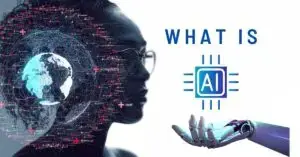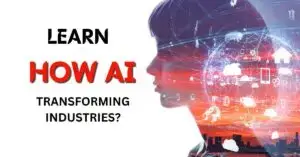I’ve always been excited about AI’s fast progress. From simple rule-based systems to today’s deep learning, AI’s journey is amazing. Each AI generation has brought breakthroughs, challenges, and ways to use this technology.
In this article, we’ll quickly explore AI’s evolution. We’ll look at the key milestones and developments of each generation. This will help you understand how we got to today’s advanced AI. Whether you’re new to AI or have been around for a while, this overview will give you a fresh view of AI’s past, present, and future.
what are the generations of AI technology?
A dynamic visual representation of the evolution of AI technology, illustrating multiple generations in a futuristic landscape, featuring abstract designs of neural networks, robotic figures, and digital interfaces that blend seamlessly into a vibrant color palette, highlighting the progression from early computers to advanced AI systems.
Key Takeaways
- Artificial intelligence has evolved through distinct generations, each marked by significant breakthroughs and technological advancements.
- The journey of AI includes the symbolic approach, the rise of knowledge-based systems, the resurgence of neural networks, and the era of machine learning and deep learning.
- The transformative impact of big data has been a crucial driver in the development of data-driven AI systems.
- The future of AI is defined by the pursuit of Artificial General Intelligence (AGI), which holds the promise of truly intelligent systems that can adapt to a wide range of tasks.
- Ethical considerations and governance frameworks are essential as AI technology becomes more pervasive in our lives.
What are the Generations of AI Technology?
The journey of artificial intelligence (AI) has seen big leaps forward, known as the “generations” of AI. These stages help us understand how AI has grown and where it’s headed.
The first AI generation, the “Symbolic Approach,” started in the 1950s and 1960s. It used rules and logic to solve problems. But, these early systems couldn’t handle the complexity of real life.
The second generation, “Knowledge-Based Systems,” came in the 1970s and 1980s. These systems built big knowledge bases and used expert reasoning. Yet, they still found it hard to adapt and learn.
The third generation, “Neural Networks and Connectionism,” began in the 1980s and 1990s. It was inspired by the brain, using nodes to learn and process information. This generation could tackle complex problems and learn from data, a big step forward.
The fourth generation, the “Machine Learning Era,” started in the 1990s and 2000s. It used statistics and algorithms to let computers learn from data. This era brought us machine learning, which has opened up new possibilities.
The fifth and current generation, “Deep Learning and Artificial Neural Networks,” has been a breakthrough. It uses big data and powerful computers to learn and perform tasks almost as well as humans. This generation has made huge strides in areas like computer vision and natural language processing.
As AI keeps evolving, we can look forward to even more changes and advancements. These will shape the future of technology and how it affects our lives.
The Dawn of AI: Symbolic Approach
The history of artificial intelligence (AI) started in the 1950s and 1960s. This was when the field was born and the Symbolic Approach was developed. Researchers worked on creating systems that could solve complex problems using symbols and logic.
The Birth of AI
In the 1950s, AI became its field, thanks to pioneers like John McCarthy, Marvin Minsky, and Allen Newell. They believed computers could be made to think and solve problems like humans.
Symbolic AI Systems
These early AI systems used rules and knowledge to process symbols. They didn’t rely on data like we do today. The Symbolic Approach focuses on logical thinking and organizing knowledge in a clear way.
| Characteristic | Symbolic AI |
|---|---|
| Approach | Rule-based programming and knowledge representation |
| Focus | Logical reasoning and formal knowledge representation |
| Examples | Expert systems, logic-based reasoning systems |
The Symbolic Approach helped create expert systems and other AI tools that use clear rules. This early work set the stage for AI’s growth, including the use of neural networks and machine learning.
The Rise of Knowledge-Based Systems
In the 1970s and 1980s, a new AI generation emerged. It was called knowledge-based systems, or expert systems. These systems were made to think like human experts. They used big databases of knowledge to solve complex problems in fields like medicine, engineering, and finance.
At the heart of these systems were large knowledge bases. They had rules, facts, and heuristics from human experts. These systems used logic to make decisions and give expert advice. This was a big change from earlier AI that focused on solving general problems.
Knowledge-based systems were great because they could explain their decisions. This was very important in fields like medicine and finance, where trust and accountability mattered a lot.
But, these systems had their limits. They struggled with the complexities and uncertainties of real-world problems. As AI kept growing, new systems came along. They brought new ways and technologies to tackle these challenges.
“Knowledge-based systems represented a significant step forward in the field of AI, showcasing the potential of expert-level decision-making capabilities within specialized domains.”
Neural Networks and Connectionism
In the 1980s and 1990s, AI saw a big comeback. This was thanks to neural networks and connectionism, inspired by the brain. These networks are learned and adapted by training on lots of data. This led to big steps forward in recognizing patterns, understanding language, and analyzing images.
The Resurgence of AI
The comeback of AI was fueled by better computers and more data. People started to see how neural networks could learn and beat old AI systems. This interest in neural networks and connectionism opened the door to many new AI achievements.
Neural Network Architectures
- Feedforward Neural Networks: These networks process information in a unidirectional manner, with data flowing from the input layer through the hidden layers to the output layer.
- Recurrent Neural Networks: Designed to process sequential data, these networks have feedback connections that allow them to consider past inputs and outputs when making decisions.
- Convolutional Neural Networks: Primarily used for image and visual processing, these networks consist of specialized layers that extract and learn features from the input data.
- Generative Adversarial Networks: These networks pit two neural networks against each other, with one generating realistic samples and the other discriminating between real and generated data.
| Neural Network Architecture | Key Features | Applications |
|---|---|---|
| Feedforward Neural Networks | Unidirectional data flow, simple structure | Pattern recognition, classification |
| Recurrent Neural Networks | Feedback connections, sequential data processing | Natural language processing, speech recognition |
| Convolutional Neural Networks | Specialized layers for feature extraction, visual processing | Image recognition, object detection |
| Generative Adversarial Networks | Adversarial training, realistic data generation | Image synthesis, text generation |
“The resurgence of neural networks and connectionism in the 1980s and 1990s marked a significant turning point in the history of AI, paving the way for the rapid advancements we see today.”
The Era of Machine Learning
The 1990s and 2000s were a big change in artificial intelligence (AI). This time saw the rise of machine learning. It’s a way AI learns from data without being told what to do. This lets AI systems get better over time.
Supervised Learning
Supervised learning was a big step forward. These algorithms learn from data that are already labeled. They look at patterns to make good predictions and decisions.
They’re used for things like recognizing images and understanding language. They’re also good at predicting what will happen next.
Unsupervised Learning
Unsupervised learning is another important part of machine learning. These algorithms find patterns in data without knowing what to look for. They’re great for finding out who your customers are and spotting unusual data points.
They help us understand data better. This shows how AI can find important things on its own.
Both supervised and unsupervised learning have helped AI a lot. They’ve made AI better at solving hard problems. This has changed many industries and will keep shaping technology’s future.
“Machine learning is the heart of artificial intelligence (AI) – it’s what gives systems the ability to automatically learn and improve from experience without being explicitly programmed.”
Deep Learning and Artificial Neural Networks
Artificial intelligence has seen big leaps forward, thanks to deep learning and artificial neural networks. These tools have changed how AI solves complex problems. They help in tasks like understanding language, seeing images, and making decisions on their own.
At the core of deep learning is the artificial neural network. It’s like a brain model made of layers of neurons. These layers work together to process and share information. Deep learning uses lots of data and powerful computers to find hidden patterns, making AI smarter and more adaptable.
“Deep learning has the potential to transform every industry, from healthcare to transportation to finance. The rapid advancements in this field are truly remarkable and will continue to shape the future of artificial intelligence.”
Deep learning and artificial neural networks have greatly impacted AI. They’ve helped AI systems solve harder problems, leading to big wins in image recognition, language understanding, and predicting future events. As AI keeps growing, we’ll see even more amazing things thanks to deep learning and neural networks.
Deep Learning
In short, deep learning and artificial neural networks have been huge game-changers in AI. They’ve made AI systems smarter, able to do things humans thought were only for us. As AI keeps getting better, we’ll see even more changes that will change how we live and work.
The Transformative Impact of Big Data
In the world of artificial intelligence (AI), big data has been a game-changer. It has opened up new possibilities for AI systems to work with huge amounts of data. This has allowed AI to find deeper insights, make more accurate predictions, and offer personalized solutions that were once impossible.
Data-Driven AI
The combination of big data and AI has ushered in a new era. These systems can now use massive datasets to improve their performance. They excel in predictive analytics, personalized recommendations, and image recognition. AI can now solve complex problems more precisely and effectively.
Challenges of Big Data
Big data has pushed AI forward, but it also brings challenges. The vast amounts of data can be hard to manage and store. Companies face issues like data storage, integration, and security. They must also address data privacy and bias to ensure AI is developed responsibly.
| Challenges of Big Data | Potential Solutions |
|---|---|
| Data Storage | Cloud-based solutions, distributed storage systems |
| Data Processing | Parallel processing, in-memory computing, stream processing |
| Data Integration | Data lakes, data warehouses, ETL (Extract, Transform, Load) tools |
| Data Security and Privacy | Encryption, access controls, data anonymization |
| Bias and Fairness | Algorithmic bias testing, diversifying data sources, ethical AI frameworks |
As big data evolves, the AI community must tackle these challenges head-on. This will unlock the full potential of data-driven AI.
“The true promise of big data lies in its ability to transform the way we make decisions and solve problems. By harnessing the power of data-driven AI, we can unlock game-changing insights and deliver solutions that truly make a difference.”
The Future of AI: Artificial General Intelligence (AGI)
The next big step in AI is Artificial General Intelligence (AGI). AGI systems can do anything a human can, across many areas. But making AGI is a big challenge. It needs better reasoning, learning, and self-awareness.
AGI could change our lives in big ways. It could solve hard problems, bring new ideas, and help us understand intelligence better. Researchers and engineers are working hard to make this happen.
Some key areas to focus on for AGI include:
- Creating AI that can solve any problem
- Improving learning algorithms for better adaptability
- Adding reasoning, abstraction, and common sense to AI
- Exploring self-awareness, consciousness, and embodied intelligence
Getting to AGI won’t be easy, but the benefits are huge. AGI could lead to big advances in science, medicine, and technology. It could shape our future society.
“The development of full artificial intelligence could spell the end of the human race… It would take off on its own, and re-design itself at an ever-increasing rate. Humans, who are limited by slow biological evolution, couldn’t compete, and would be superseded.”
Artificial general intelligence
A futuristic humanoid figure with intricate circuitry and glowing neural pathways, surrounded by a digital landscape filled with holographic interfaces and symbols of knowledge. The atmosphere is a blend of vibrant colors, suggesting advanced technology and interconnected networks, while a soft light emanates from the figure, representing the essence of artificial general intelligence.
The journey to AGI is exciting and complex. It’s a challenge that fascinates scientists, tech experts, and the public. The future of AI promises great breakthroughs, but we must also think about ethics.
Ethical Considerations and AI Governance
Artificial intelligence (AI) is growing fast, and so are the ethical and governance challenges it brings. Issues like ai bias, ai fairness, ai privacy, and ai security need careful thought. This ensures AI systems are made and used responsibly and openly.
Bias and Fairness
Ai ethics face a big challenge: algorithmic bias. AI systems can keep or even grow biases, leading to unfair outcomes. This is seen in hiring, lending, and healthcare. To fix this, policymakers and leaders are creating rules to ensure ai fairness and reduce bias.
Privacy and Security
AI’s growth also raises ai privacy and AI security worries. AI systems handle a lot of data, and keeping this data safe is key. Also, AI could be used for bad things, like cyberattacks. So, strong ai governance is needed to protect against these threats.
| Ethical Consideration | Key Challenges | Proposed Solutions |
|---|---|---|
| ai bias and ai fairness | – Perpetuating societal biases – Discriminatory outcomes in decision-making | – Developing ethical AI frameworks – Algorithmic auditing and testing |
| ai privacy and ai security | – Data privacy and protection – Potential for misuse and cyberattacks | – Robust data governance policies – Cybersecurity measures for AI systems |
As AI grows, policymakers, researchers, and industry leaders need to work together. They need to create ethical guidelines and AI governance to shape AI’s future. By tackling these key issues, we can make sure AI is used for good and in a way that benefits everyone.
Conclusion
The journey of AI technology has been amazing, with each generation adding new layers. It started with symbolic AI and now we have deep learning and data-driven AI. This change has opened up new possibilities and brought new challenges.
Exploring AI technology shows how each generation has led to big breakthroughs. Knowledge-based systems, neural networks, and machine learning have all played a part. They’ve changed how we see and work with smart systems.
The future looks bright with Artificial General Intelligence (AGI). It could make human and machine intelligence seem more alike. But, we must face the ethical and governance issues that come with AI. We need to work on bias, fairness, privacy, and security to make sure AI helps us in a good way.
FAQ
What are the generations of AI technology?
AI technology has evolved through several generations. Each generation has its own unique approaches and advancements. These include the Symbolic Approach, Knowledge-Based Systems, Neural Networks, Machine Learning, and Deep Learning.
How has the field of AI developed over time?
AI started with the Symbolic Approach in the 1950s and 1960s. Then, Knowledge-Based Systems emerged in the 1970s and 1980s. The 1980s and 1990s saw a comeback of Neural Networks.
By the 1990s and 2000s, Machine Learning became popular. Now, we focus on Deep Learning and Artificial Neural Networks. These advancements have made AI systems more capable.
What are the key milestones and breakthroughs in the history of AI?
Key milestones include the first Symbolic AI systems and the creation of expert systems. The 1980s and 1990s saw a resurgence in Neural Networks.
Machine Learning algorithms rose in the 1990s and 2000s. Recent advancements in Deep Learning have led to big progress in areas like pattern recognition and natural language processing.
How have the different generations of AI technology impacted the field?
Each generation has shaped AI development and design. The Symbolic Approach and Knowledge-Based Systems laid the groundwork for AI systems.
The 1980s and 1990s brought advancements in pattern recognition and natural language processing. Machine Learning made AI more adaptive and data-driven. Today, Deep Learning and Artificial Neural Networks are tackling complex problems.
What are the ethical considerations and governance challenges surrounding AI?
AI’s advancement raises ethical and governance challenges. Issues like algorithmic bias, fairness, privacy, and security need attention. It’s important to ensure AI systems are developed responsibly.
Policymakers, researchers, and industry leaders are working on ethical frameworks and governance. This will guide AI’s future and mitigate risks.
What is the ultimate goal of AI research?
Many AI researchers aim to create Artificial General Intelligence (AGI). AGI would match or exceed human intelligence in various tasks. Current AI systems excel in specific areas, but AGI is a significant challenge.
The pursuit of AGI is the next step in AI’s evolution. It could transform many aspects of our lives.




